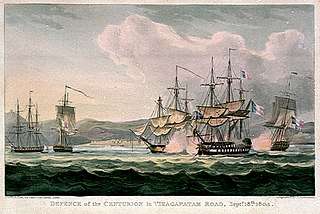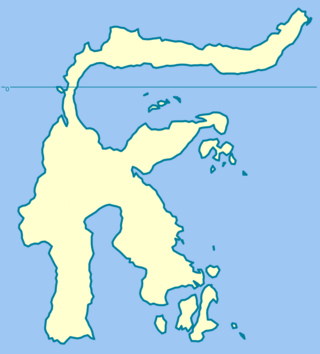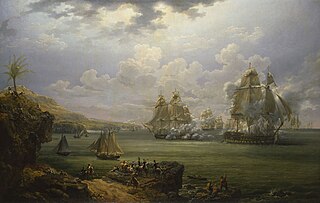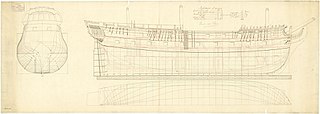
Guerrière was a 38-gun frigate of the French Navy, designed by Forfait. The British captured her and recommissioned her as HMS Guerriere. She is most famous for her fight against USS Constitution.

Charles-Alexandre Léon Durand, Comte de Linois was a French admiral who served in the French Navy during the reign of Napoleon Bonaparte. He commanded the combined Franco-Spanish fleet during the Algeciras Campaign in 1801, winning the First Battle of Algeciras before losing the Second Battle of Algeciras. He then led an unsuccessful campaign against British trade in the Indian Ocean and South China Sea in 1803, being defeated by a harmless fleet of the East India Company during the Battle of Pulo Aura and ending his cruise and sea-going career being bested in battle by John Warren in the action of 13 March 1806. Following the Bourbon restoration, Linois was appointed Governor of Guadeloupe. He supported Napoleon during the Hundred Days and so, on his return to France, he was forced to resign and was court martialled. Although acquitted, he was placed in retirement and never served again.

HMS Implacable was a 74-gun third-rate ship of the line of the Royal Navy. She was originally the French Navy's Téméraire-class ship of the line Duguay-Trouin, launched in 1800.

The Mauritius campaign of 1809–1811 was a series of amphibious operations and naval actions fought to determine possession of the French Indian Ocean territories of Isle de France and Île Bonaparte during the Napoleonic Wars. The campaign lasted from the spring of 1809 until the spring of 1811, and saw both the Royal Navy and the French Navy deploy substantial frigate squadrons with the intention of disrupting or protecting trade from British India. In a war in which the Royal Navy was almost universally dominant at sea, the campaign is especially notable for the local superiority enjoyed by the French Navy in the autumn of 1810 following the British disaster at the Battle of Grand Port, the most significant defeat for the Royal Navy in the entire conflict. After their victory, the British used the original Dutch name of Mauritius for Isle de France. In 1814, Île Bonaparte was returned to France, who eventually renamed it La Réunion.
The action of 13 September 1810 was an inconclusive frigate engagement during the Napoleonic Wars between British Royal Navy and French Navy frigates during which a British frigate was defeated by two French vessels near Isle de France, but British reinforcements were able to recapture the ship before the French could secure her. The British frigate was HMS Africaine, a new arrival to the Indian Ocean. She was under the command of Captain Robert Corbet, who had served there the previous year. Corbet was a notoriously unpopular officer and his death in the battle provoked a storm of controversy in Britain over claims that Corbet had either committed suicide at the shame of losing his ship, been murdered by his disaffected crew, or been abandoned by his men, who were said to have refused to load their guns while he remained in command. Whether any of these rumours were accurate has never been satisfactorily determined, but the issue has been discussed in several prominent naval histories and was the subject of at least one lawsuit.

Linois's expedition to the Indian Ocean was a commerce raiding operation launched by the French Navy during the Napoleonic Wars. Contre-Admiral Charles-Alexandre Durand Linois was ordered to the Indian Ocean in his flagship Marengo in March 1803 accompanied by a squadron of three frigates, shortly before the end of the Peace of Amiens. When war between Britain and France broke out in September 1803, Marengo was at Pondicherry with the frigates, but escaped a British squadron sent to intercept it and reached Isle de France. The large distances between naval bases in the Indian Ocean and the limited resources available to the British commanders in the region made it difficult to concentrate sufficient forces to combat a squadron of this size, and Linois was subsequently able to sustain his campaign for three years. From Isle de France, Linois and his frigates began a series of attacks on British commerce across the Eastern Indian Ocean, specifically targeting the large convoys of East Indiamen that were vital to the maintenance of trade within the British Empire and to the British economy. Although he had a number of successes against individual merchant ships and the small British trading post of Bencoolen, the first military test of Linois squadron came at the Battle of Pulo Aura on 15 February 1804. Linois attacked the undefended British China Fleet, consisting of 16 valuable East Indiamen and 14 other vessels, but failed to press his military superiority and withdrew without capturing a single ship.

The Battle of Vizagapatam was a minor naval engagement fought in the approaches to Vizagapatam harbour in the Coastal Andhra region of British India on the Bay of Bengal on 15 September 1804 during the Napoleonic Wars. A French squadron under Contre-Admiral Charles-Alexandre Léon Durand Linois in the ship of the line Marengo attacked the British Royal Navy fourth rate ship HMS Centurion and two East Indiaman merchant ships anchored in the harbour roads. Linois was engaged in an extended raiding campaign, which had already involved operations in the South China Sea, in the Mozambique Channel, off Ceylon and along the Indian coast of the Bay of Bengal. The French squadron had fought one notable engagement, at the Battle of Pulo Aura on 15 February 1804, in which Linois had attacked the Honourable East India Company's (HEIC) China Fleet, a large convoy of well-armed merchant ships carrying cargo worth £8 million. Linois failed to press the attack and withdrew with the convoy at his mercy, invoking the anger of Napoleon when the news reached France.

The action of 9 July 1806 was a minor engagement between a French privateer frigate and British forces off Southern Ceylon during the Napoleonic Wars. French privateers operating from the Indian Ocean islands of Île Bonaparte and Île de France were a serious threat to British trade across the Indian Ocean during the Wars, and the British deployed numerous methods of intercepting them, including disguising warships as merchant vessels to lure privateers into unequal engagements with more powerful warships. Cruising near the Little Basses Reef on the Southern coast of Ceylon, the 34-gun privateer Bellone was sighted by the 16-gun British brig HMS Rattlesnake, which began chasing the larger French vessel. At 15:15, a third ship was sighted to the south, which proved to be the 74-gun ship of the line HMS Powerful, disguised as an East Indiaman.

The action of 26 July 1806 was a minor naval engagement of the Napoleonic Wars fought off the southern coast of the island of Celebes in the Dutch East Indies. During the battle, a small British squadron attacked and defeated a Dutch force defending a valuable convoy, which was also captured. The British force—consisting of the frigate HMS Greyhound and brig-sloop HMS Harrier under the command of Captain Edward Elphinstone—was initially wary of the Dutch, mistaking the Dutch East Indiaman merchant ship Victoria for a ship of the line. Closer observation revealed the identity of the Dutch vessels the following day and Elphinstone led his frigate against the leading Dutch warship Pallas while Harrier engaged the merchant vessels and forced them to surrender. Only the corvette William escaped, taking no part in the engagement.

The Java campaign of 1806–1807 was a minor campaign during the Napoleonic Wars by British Royal Navy forces against a naval squadron of the Kingdom of Holland, a client state of the French Empire, based on the island of Java in the Dutch East Indies. Seeking to eliminate any threat to valuable British merchant convoys passing through the Malacca Straits, Rear-Admiral Sir Edward Pellew determined in early 1806 that the Dutch naval forces based at Java, which included several ships of the line and three frigates, had to be defeated to ensure British dominance in the region. Lacking the forces to effect an invasion of the Dutch colony, Pellew instead sought to isolate and blockade the Dutch squadron based at Batavia in preparation for raids specifically targeting the Dutch ships with his main force.
The Raid on Griessie was a British attack on the Dutch port of Griessie on Java in the Dutch East Indies in December 1807 during the Napoleonic Wars. The raid was the final action in a series of engagements fought by the British squadron based in the Indian Ocean against the Dutch naval forces in Java, and it completed the destruction of the Dutch squadron with the scuttling of three ships of the line, the last Dutch warships in the region. The British squadron—under the command of Rear-Admiral Sir Edward Pellew—sought to eliminate the Dutch in an effort to safeguard the trade route with China, which ran through the Straits of Malacca and were in range of Dutch raiders operating from the principal Javan port of Batavia. In the summer of 1806, British frigates reconnoitred Javan waters and captured two Dutch frigates, encouraging Pellew to lead a major attack on Batavia that destroyed the last Dutch frigate and several smaller warships. Prior to the Batavia raid however, Dutch Rear-Admiral Hartsinck had ordered his ships of the line to sail eastwards, where they took shelter at Griessie, near Sourabaya.

The Sunda Strait campaign of January 1794 was a series of manoeuvres and naval actions fought between warships and privateers of the French Republic and a squadron of vessels sent by the British East India Company to protect trade in the region, later augmented by Dutch warships. The campaign developed as French forces based on Île de France reacted more quickly than the British forces in the Indian Ocean to the expansion of the French Revolutionary Wars on 1 February 1793. French privateers rapidly spread along the British trade routes in the Far East, becoming concentrated around the narrow Sunda Strait between the islands of Java and Sumatra in the Dutch East Indies. These ships were soon joined by French Navy frigates and began to inflict losses on shipping in the region. The Royal Navy forces in the Indian Ocean were deployed elsewhere and so the East India Company, the private enterprise that ruled much of British India in the 1790s and maintained their own fleet and navy, raised a squadron of armed merchant ships to patrol the Strait and drive off the raiders.
HMS Orpheus was a 32–gun fifth rate frigate of the Royal Navy. She was launched in 1780, and served for more than a quarter of a century, before she was wrecked in 1807.

The blockade of Saint-Domingue was a naval campaign fought during the first months of the Napoleonic Wars in which a series of British Royal Navy squadrons blockaded the French-held ports of Cap-Français and Môle-Saint-Nicolas on the northern coast of the French colony of Saint-Domingue, soon to become Haiti, after the conclusion of the Haitian Revolution on 1 January 1804. In the summer of 1803, when war broke out between the United Kingdom and the French Consulate, Saint-Domingue had been almost completely overrun by Haitian Armée Indigène troops led by Jean-Jacques Dessalines. In the north of the country, the French forces were isolated in the two large ports of Cap-Français and Môle-Saint-Nicolas and a few smaller settlements, all supplied by a French naval force based primarily at Cap-Français.

The Battle of Île Ronde was a minor naval engagement between small French Navy and British Royal Navy squadrons off Île de France, now named Mauritius, in the early stages of the French Revolutionary Wars. The battle was fought over control of the waters around Île de France, which was under blockade from the British squadron as French warships and privateers operating from the island posed a significant threat to vital British trade routes connected to British India and China.
Princess Royal, launched in 1786, was an East Indiaman. She made two complete trips to India for the British East India Company (EIC) and was on her third trip, this one to China, when French privateers or warships captured her on 27 September 1793. The French Navy took her into service in the Indian Ocean as a 34-gun frigate under the name Duguay Trouin. The Royal Navy recaptured her and she returned to British merchant service. In 1797 she performed one more voyage for the EIC. She received a letter of marque in July 1798 but was captured in October 1799 off the coast of Sumatra.

The East Indies theatre of the French Revolutionary Wars was a series of campaigns related to the major European conflict known as the French Revolutionary Wars, fought between 1793 and 1801 between the new French Republic and its allies and a shifting alliance of rival powers. Although the Indian Ocean was separated by vast distance from the principal theatre of the conflict in Western Europe, it played a significant role due to the economic importance of the region to Great Britain, France's most constant opponent, of its colonies in India and the Far Eastern trade.

During the late 18th and early 19th centuries, many French privateers and letters of marque bore the name Duguay-Trouin, named for René Duguay-Trouin: René Trouin, Sieur du Gué, French privateer, admiral and Commander in the Order of Saint Louis. Between 1760 and 1810, warships of the Royal Navy captured seven different French privateers all with the name Duguay-Trouin.

HMS Resistance was a 44-gun fifth-rate Roebuck-class ship of the Royal Navy launched in 1782. Based on the design of HMS Roebuck, the class was built for use off the coast of North America during the American Revolutionary War. Commissioned by Captain James King, Resistance served on the West Indies Station for the rest of the war. She captured the 24-gun corvette La Coquette on 2 March 1783 and then went on in the same day to participate in the unsuccessful Battle of Grand Turk alongside Horatio Nelson. Resistance then went for a refit in Jamaica, during which time King fell ill and was replaced by Captain Edward O'Bryen. O'Bryen commanded Resistance until March 1784 when she was paid off. In 1791 she was recommissioned as a troop ship, but was converted back into a warship in 1793 at the start of the French Revolutionary War, under Captain Edward Pakenham.

Rear-Admiral Sir Thomas Hardy was a Royal Navy officer of the late 17th and early 18th centuries. Having joined the navy sometime before 1688, Hardy's career was supported by Captain George Churchill, whom he served as first lieutenant during the Battle of Barfleur in 1692. Promoted to captain in 1693, Hardy served in the Channel Islands and off the coast of England until 1702 when he was given command of HMS Pembroke off the coast of Spain. He fought at the Battle of Cádiz, and subsequently discovered the location of the Franco-Spanish fleet through the intervention of his chaplain, which resulted in the Battle of Vigo Bay. Hardy was knighted for his services.















